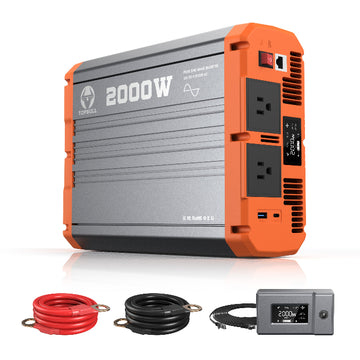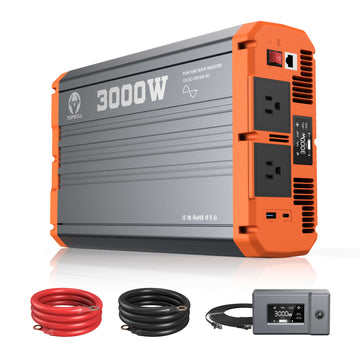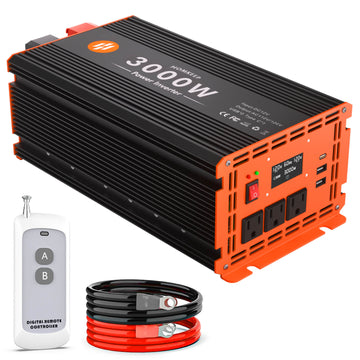Have you ever wondered if your portable induction cooktop uses too much power or if it's compatible with your home setup? Many users praise induction burners for their fast heating, energy efficiency, and safety, but others struggle with power limitations, circuit compatibility, or inverter selection when using them off-grid.
Understanding the power requirements of these cooktops is crucial for making the right choice, whether you're upgrading your kitchen, living in an RV, or preparing for emergency backup power. This guide breaks down how many watts a portable induction burner needs, factors affecting energy use, efficiency tips, and how to choose the right power inverter!
Power Requirements of Portable Induction Burners
Before purchasing a portable induction burner, you need to understand its power requirements to ensure compatibility with your electrical system. Below, we break down the key electrical considerations that determine not only how well the cooktop performs but also whether your home or off-grid setup can support it.
Power Range
Portable induction burners typically operate within a 100W to 1800W range, allowing you to adjust heat levels based on cooking needs. Low-power settings (100W–500W) are ideal for simmering or melting, while high-power settings (1200W–1800W) enable fast boiling and searing. Some commercial-grade induction burners exceed 1800W, providing even more power but often requiring special electrical configurations.
Voltage Compatibility
Most household induction burners are designed for 120V outlets, which are standard in North American homes. This makes them convenient for most kitchens without requiring electrical modifications. However, higher-wattage induction burners (above 1800W), commonly found in commercial kitchens or heavy-duty cooking applications, often require 240V power sources. If you're considering a high-power model, ensure your home's electrical system can support the required voltage.
Current Requirements
An 1800W induction burner typically draws around 15A of current. Since many standard household circuits are rated at 15A or 20A, running an induction burner on the same circuit as other high-power appliances (e.g., microwaves, refrigerators) may overload the circuit and trip the breaker. It's advisable to check your electrical panel and, if needed, dedicate a separate circuit for your induction burner to prevent disruptions.
Factors Affecting the Power Consumption of Induction Burners
While induction burners are known for their efficiency, their actual power consumption depends on several factors. Here are the factors that can help you optimize energy use while maintaining cooking performance.
Adjustable Power Levels
Most portable induction cooktops feature adjustable power settings ranging from 100W to 1800W, allowing you to control energy consumption based on your cooking needs. Lower power settings consume less electricity, while higher settings enable faster cooking. Choosing the right power level for each dish can significantly impact overall energy efficiency.
Cooking Mode
Different cooking techniques require varying power levels, affecting electricity usage:
-
High-power settings (1200W – 1800W): Best for tasks requiring intense heat, such as boiling water, frying, and searing.
-
Medium-power settings (600W – 1000W): Ideal for general cooking tasks like sautéing and steaming.
- Low-power settings (100W – 500W): Suitable for simmering, melting, and slow cooking, consuming the least energy.
Using an unnecessarily high power level for simple tasks can lead to wasted energy, so adjusting settings appropriately is key to efficient use.
Cooking Duration
Longer cooking times at high power settings naturally increase energy consumption, while shorter durations and lower settings help conserve electricity. For example, simmering soup for hours at 500W will use less energy than repeatedly reheating it at 1500W. Proper meal planning, preheating only when necessary, and using lids to retain heat can further reduce energy waste.
Will a 2000W Inverter Run an Induction Cooktop?
Using an inverter to power an induction cooktop requires careful consideration of power ratings, surge capacity, and inverter type. Induction burners draw substantial power, and choosing the wrong inverter can result in overloads, inefficiency, or device failure.
Inverter Power Calculation
To ensure smooth operation, your inverter should provide at least 20% to 30% more power than the induction cooktop's rated wattage. This extra margin compensates for fluctuations and prevents the inverter from running at full capacity continuously. For example:
- An 1800W induction burner requires a minimum 2200W pure sine wave inverter to function reliably.
- A lower-rated 1500W burner would need at least a 2000W inverter to prevent overload.
Discover More About 2000W Power Inverters:
What Can a 2000W Inverter Run? Fridges, TVs, & More!
Wire Size for 2000 Watt Inverter: Gauge, Fuse, & Battery Cable
Startup Power Surge
Induction burners can have a startup surge that is 2 to 3 times their rated power due to rapid heating demands. This means:
- An 1800W induction burner may momentarily require up to 5000W during startup.
- A 1500W burner could surge up to 4000W, depending on the model.
If the inverter cannot handle this surge, the cooktop may fail to start or cause the inverter to shut down. Choosing an inverter with a sufficient surge rating is crucial for reliable performance.
Best Power Inverters for Indcution Burner
If you're running an induction burner off-grid or via a battery-inverter system, a pure sine wave inverter is essential. Modified sine wave inverters can cause malfunctions, overheating, or failure in induction cooktops. Here are 3 recommended options from Topbull:
-
2000W Pure Sine Wave Inverter - Ideal for lower-rated 1500W induction burners, preventing the risks of overload.
-
3000W Pure Sine Wave Inverter – Suitable for most 1800W cooktops, providing a moderate buffer for surges.
- 4000W Pure Sine Wave Inverter – Offers additional overhead for higher-wattage cooktops and longer-duration cooking sessions.
For smoother operation and long-term reliability, it's best to select an inverter that not only meets but exceeds your induction cooktop's peak power demands.

FAQs About Portable Induction Burners & Power Usage
Does Using an Induction Cooktop Increase My Electricity Bill?
Induction cooktops are more energy-efficient than traditional gas and electric stoves. However, their impact on your electricity bill depends on several factors:
-
Power Setting: Higher wattage settings consume more electricity.
-
Cooking Duration: Longer cooking times naturally increase energy use.
- Local Electricity Rates: Costs vary based on your area's electricity pricing.
That said, due to their high efficiency (up to 90%), induction burners generally use less energy compared to conventional stoves, leading to lower long-term energy costs.
Why Doesn't My Induction Burner Reach Its Maximum Power?
If your induction cooktop is underperforming, consider these possible causes:
-
Low Voltage Supply – If your home's electrical system isn't delivering stable voltage, the burner may not reach its full power potential.
-
Circuit Limitations – Overloaded circuits can reduce available power. Ensure your outlet provides sufficient amperage for the cooktop's requirements.
-
Improper Cookware – Induction burners only work with magnetic cookware (such as cast iron or specific stainless steel). Incompatible or warped-bottom pans can reduce efficiency.
- Internal Safety Restrictions – Many cooktops have built-in overheat protection that automatically reduces power to prevent damage or excessive heat buildup.
How Do I Choose the Right Portable Induction Burner?
Selecting the best induction cooktop depends on your cooking habits and needs. Consider these key factors:
-
Power Rating: Higher wattage models (1500W–1800W) provide faster cooking times, while lower wattage models (under 1000W) are ideal for slow cooking or travel use.
-
Portability: Compact, lightweight designs are better for small kitchens, RVs, and outdoor cooking.
-
Safety Features: Look for automatic shutoff, child safety locks, and overheating protection for a safer cooking experience.
- Voltage Requirements: Ensure the cooktop is compatible with your home's electrical system (most are designed for 120V in North America, while some high-power models require 240V).
Final Words
By reading this article, you now understand how many watts a portable induction burner needs and why it is an energy-efficient, safe, and versatile cooking solution. Pair your cooktop with our recommended Topbull pure sine power inverters and choose the right power capacity to enjoy a reliable, efficient, and modern cooking experience—whether at home, in an RV, or during emergencies!
















